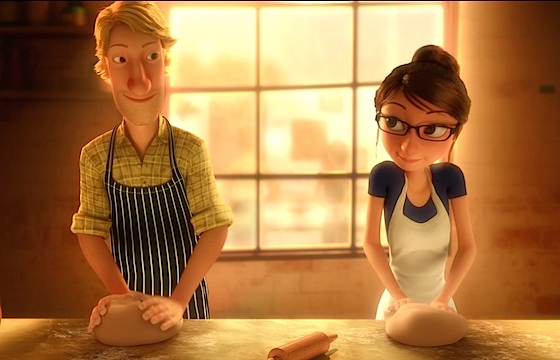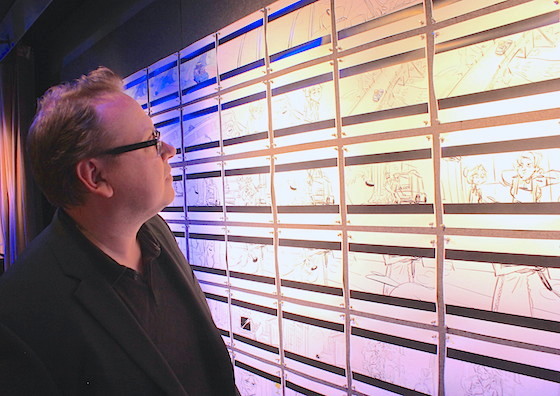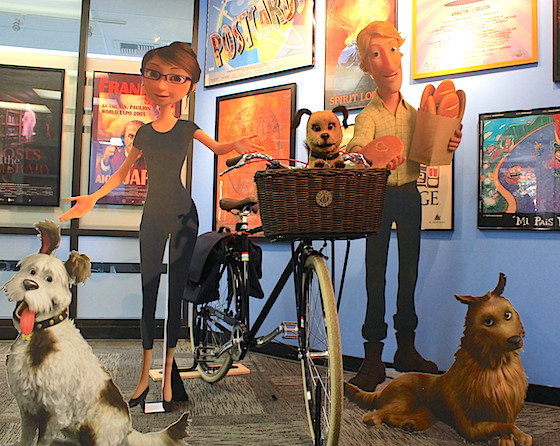If you're down about Disney bringing Frozen to Epcot and the dearth of new attractions that aspire to do more than just sell toys, take heart. Despite what some characters in Tomorrowland might have you believe, hope for building a better world isn't a lost cause in the themed entertainment industry.
Heck, we even still have World's Fairs, too.
The latest World's Fair, Expo Milano 2015, opened in Italy last month. Yesterday, the team at BRC Imagination Arts in Burbank, Calif. invited me over to take a look at the attraction that they developed for the European Union's exhibition at the fair.

"The Golden Ear" tells the story of a young scientist, Sylvia, and a wheat farmer, Alex, who learn that by working together they can do far more than they can by working alone. Sure, at its heart it's yet another animated boy-meets-girl story. But in the hands of storytellers charged with a purpose, the story of Sylvia and Alex illustrates how themed entertainment still offers the potential to inspire people to think about more than just what souvenir toy they want to buy next.
"The storyline very softly sells a very difficult and challenged brand right now," said Bob Rogers, the founder of BRC Imagination Arts and one of the producers of the new film. "The EU is not exactly at the peak of its popularity throughout Europe. Some people feel it's too hard. Some people feel it's too soft. But no one feels that it is just right. Our job is to come in and soften the image while at the same time addressing deeply, deeply important issues."
"We wanted to do something that spoke to [visitors'] hearts, something that would connect, and, at the end of the day, create a togetherness story," said BRC's Christian Lachel, who directed the film. "The word is in there — the European Union. What is a union? We thought if people, especially young people, if they walked out feeling good, feeling positive about the world that they live in — the Europe that they're going to grow up in — and if they walked away feeling that, by working together, they can make a better world... then that was the win. That was really the big idea for us, really [creating] that idea of togetherness.

"Through that, we started to look at a storyline that was told through two characters. And the two characters were symbolic of the ideas of science and agriculture, which are at the base of European policy.... Sylvia represents the science aspects of the story. She's a bit modern. She's into climate science and she really does want to make the world a better place. Alex, on the other hand, is also somebody who wants to make the world a better place, but he's a bit more local — lives in a small village — fourth-generation farmer. But they're both missing something in their lives... and then they meet each other."
"It's about bringing two different worlds together, and by doing that, they become stronger."
In the nine-minute animated film, Sylvia's called to her grandmother's bakery, which she tries to run while her grandmother leaves on holiday. Despite her best efforts, Sylvia's bread just doesn't meet the taste test. But the local farmer who delivers the wheat flour to the bakery, Alex, notices her struggling. While she might not have a feel for baking, he's especially impressed with her knowledge of climate and her attempts to inspire the village to reinforce the local dam before the next flood. When that flood comes, the two work together to protect the town, then start working together to bake some tastier bread.
The film plays without dialogue, telling its story through animated visuals. With CG production by Prana Animation Studios, the movie reflects a "pastiche," as Rogers said, of multiple European cultures, allowing it to be of no particular place, yet every place, at the same time.
After watching the film, visitors exit into a post-show area that features three video touch walls, where viewers can discover more about the new bakery that Sylvia and Alex open after the events of the main film, the village in which they live, and the relief efforts that they will provide to the needy around the world. Hot spots on the screens allow visitors to activate hidden animation or spawn windows with addition information about the story and about issues of food production, climate change, and resource management gently raised by the film.
While the issues addressed are modern, the storytelling is timeless, and the attraction feels as though something that would fit well in a 21st century update of the 1980s Epcot. That makes sense, given that Rogers worked on the old World of Motion pavilion in Future World and produced the "Impressions de France" film that continues to show in the park's France pavilion. But will people a generation from now remember Sylvia and Alex as fondly as many fans look upon Rogers' Epcot productions?

"These characters are already finding their way into EU literature," Rogers said. "I wouldn't be surprised, although it was never planned, if 10 years from now, these characters are still the face of the EU."
Tweet
This article has been archived and is no longer accepting comments.